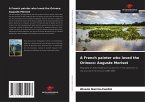Tucked away in an attic of a historic French building and in the Louvre's conservation department, Rogier van der Weyden's Last Judgment painting went unnoticed for centuries until it became part of the L'hôtel-Dieu museum in Beaune. The intriguing thing is that, in 1443, the altarpiece was commissioned to be part of the chapel of a 15th-century place for caring for the sick and poor. The purpose of the image begs the question: what was the function of a representation of the end of the world in the 15th century? And why was a painting of the Last Judgement more than 5 meters long and 2 meters high part of the scenery of a place where the poor and sick were cared for? It is true that many images of the Last Judgement appeared at this time. But the peculiar thing is precisely the location of the image. These and other questions are the essence of this book, which aims to offer the reader an image analysis based on the evidence found in the Last Judgement altarpiece.
Bitte wählen Sie Ihr Anliegen aus.
Rechnungen
Retourenschein anfordern
Bestellstatus
Storno








